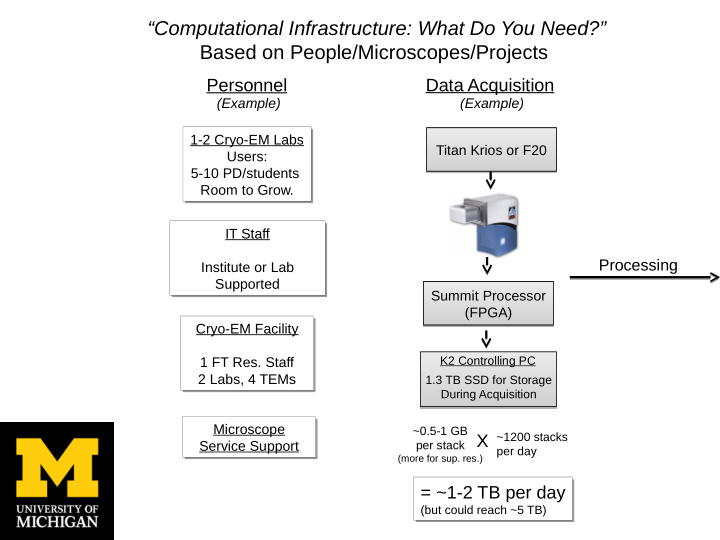



“Computational Infrastructure: What Do You Need?” Based on People/Microscopes/Projects Data Acquisition Personnel (Example) (Example) 1-2 Cryo-EM Labs 1-2 Cryo-EM Labs Titan Krios or F20 Titan Krios or F20 Users: Users: 5-10 PD/students 5-10 PD/students Room to Grow. Room to Grow. IT Staff IT Staff Processing Institute or Lab Institute or Lab Supported Supported Summit Processor Summit Processor (FPGA) (FPGA) Cryo-EM Facility Cryo-EM Facility K2 Controlling PC 1 FT Res. Staff 1 FT Res. Staff 2 Labs, 4 TEMs 2 Labs, 4 TEMs 1.3 TB SSD for Storage During Acquisition Microscope Microscope ~0.5-1 GB X ~1200 stacks Service Support per stack Service Support per day (more for sup. res.) = ~1-2 TB per day = ~1-2 TB per day (but could reach ~5 TB) (but could reach ~5 TB)
“Computational Infrastructure: What Do You Need/Buy?” (Example) 2D/3D Processing Cluster Cluster GPU CPU GPU CPU GPU Drift Correction Server 4X GeForce GTX 770 20 nodes, 160 cores 4X GeForce GTX 770 20 nodes, 160 cores 2 Intel Xeon E5-2670 ~5yrs old • 4TB SSD RAID 2 Intel Xeon E5-2670 ~5yrs old • 2 NVIDIA Tesla K20m GPUs Raw Stacks Server 1 Server 2 Server 1 Server 2 Processed Images Intel Xeon 2.4 GHz Intel Xeon 2.4 GHz Intel Xeon 2.4 GHz Intel Xeon 2.4 GHz 12 cores, 64 GB 12 cores, 64 GB 10GbE 12 cores, 64 GB 12 cores, 64 GB 10GbE RAM RAM RAM RAM Network Network Visualizing/Processing 215 TB 215 TB On ZFS On ZFS Personal Workstations Personal Workstations iMacs/G5s/Linux iMacs/G5s/Linux Primary Storage Storage/Backup Purchase piecemeal Purchase piecemeal Daily Backup to Tape Daily Backup to Tape Needs: Needs: • Institute-Wide • Institute-Wide Expandability Expandability • ~300 Tb capacity • ~300 Tb capacity Updating Every 3-5 Years Updating Every 3-5 Years • 2 copies – onsite/offsite • 2 copies – onsite/offsite
“Are so called supercomputer centers of value?” Depends on: • Data Transfer Rate – Can be to slow for back-and-forth requirements from local storage source (main bottleneck). • Storage Availability – Ideally need reasonably large, long-term storage (length of a project) to access data to avoid transferring from local storage drives . • Cost – Often pricing structure is not optimized for cryo-EM needs. Ex. $6/cpu/month ‘rental’ use with ~1TB storage is very expensive long-term. • Architecture – May not be ideal for RAM-intensive cryo-EM processing needs. -Possible Advantage: Buy-in with local/university resource – purchase own CPU’s , storage that are maintained offsite. -Still need investment in local computation resources. “What about cloud computing?” • Not an option - transfer rates too slow. • Perhaps for archiving, but cost may be high
“What software do you need up and running?” Data Acquisition Drift Correction Particle Picking -Digital Micrograph -Digital Micrograph -E2 Boxer semi-automated -FEI EPU -UCSF MOTION_CORR -RELION, others -UCSF Image -RELION, and others -Leginon -In-house scripts for data transfer 2D Classification/Analysis CTF Cor./3D Class./Refinement Many Others for: -SPIDER, EMAN, FREALIGN, RELION -SPIDER Validation, Modeling, Visualizing -ISAC, EMAN -RELION, jothers “How do you support the hardware and software?” • Leginon/Appion -Automation, many options for processing, requires good IT/cryo-EM staff support, training. • SBGrid, Harvard -Good for smaller labs, limited IT time, but costly • Excellent local/dedicated IT support • Departmental/Institute support. How do you validate the software • Use everything and compare results. • Validation of the reconstruction steps. • Talk to people, go to meetings.
Our Current Bottlenecks Transfer Rates -During Acquisition -For Processing -Backups after Acquisition Drift-correction on the fly Storage -Short-term during acquisition -long-term (TB per person?) -Archive, backup Processing -CPUs, availability, age -RAM per CPU -Head node, allocation -Optimal utilization by software
Recommend
More recommend